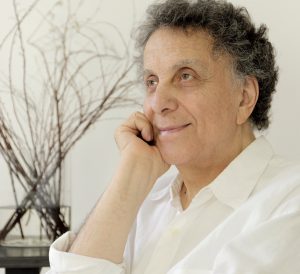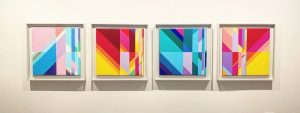Born in Jerusalem in 1942, Kamal Boullata was a pioneer in both the practice of and scholarship on contemporary Arabic art, renown for evocative works across a variety of artistic mediums, in addition to his steadfast dedication to the people, history, and rich culture of Palestine. As a young man, his promise was recognized with a scholarship that took him to Europe, where he graduated from the Accademia di Belle Arti in Rome. Upon returning home, he was at the forefront of a general art awakening in the region; however, the 1967 War forced Boullata to leave Jerusalem.
“Kamal Boullata created new possibilities for employing sociopolitical heritage in visual culture. In addition to his tremendous and varied outputs as a visual artist, Kamal must also be remembered for his profound impact on the scholarship of Arab art and culture. He was the recipient of a Fulbright Senior Scholar Award in the 1993–1994 academic year, where he researched Islamic art in Morocco, and in 2001, he received a Ford Foundation grant to pursue research on the influence of post-Byzantine art on Palestinian painting. One of his foremost Arabic language publications was Recovery of Place: A Study of Contemporary Palestinian Art, published in 2000. In 2007, he returned to his collaboration with Kathy Engel to revise and re-release their anthology, co-editing We Begin Here: Poems for Palestine and Lebanon, a compendium of outstanding American writing on conflicts in those places. The following year, Palestinian Art: From 1850 to the Present was released; this volume is sure to be remembered as one of the greatest contributions to the study of the history and culture of Palestine, and it has been described as Kamal’s magnum opus. Also in 2008, he edited Belonging and Globalization: Critical Essays in Contemporary Art and Culture. In 2012–2013, Kamal was elected a Fellow of the Wissenschaftskolleg zu Berlin, the Institute for Advanced Study in Berlin, during which time he published Between Exits, the first monograph to trace the career of Palestinian artist Hani Zurob.”*
The following testimonies are selected excerpts from articles published in the cultural section of the London-based Arabic-language newspaper Al-Araby Al-Jadeed, on 19 August. (Translated by Razan Anabtawi.)
A life of passion for Jerusalem.
Nasser Rabbat
There is in Kamal Boullata’s art, and in all his written or painted work, in fact, an urgent and clear awareness of the double marginality that the vagaries of our times have assigned to him and his people: the marginality of “the Other,” and the marginality of art as that of “the Other.” Boullata is an expert in the existential impact of “the Other,” particularly the Other exiled from his home by brutal force. He has wandered the earth not only in search of a safe harbor but to recast the many contradictions and ruptures that have shaped his life in Jerusalem and elsewhere as a howl brandished in the face of the entire world to heighten his personal, national, and, of course – since we are talking about Kamal – human tragedy.
The marginality of the Other’s art, on the other hand, is the product of the historical context in which Kamal operated: the long-standing marginality of the painterly art in comparison to other areas of expression, such as poetry and music in Arabic culture, as well as the historical context faced by Palestinian and Arab art confined to the margins of the Western-dominated global art culture.
Nasser Rabbat is the Aga Khan Professor and director of the Aga Khan Program for Islamic Architecture at the Massachusetts Institute of Technology.

Kamal Boullata: letters in a renewed lifecycle. Khélil Gouia
Kamal Boullata contributed to the accumulation of the consciousness of the aesthetic of modernity through a cycle of creatively rooting and modernizing heritage. Boullata did not import Western vocabulary either from Cezanne’s expressionism or from the cubism of Barak or Picasso. Instead, he utilized his cultural wealth to refine his terminology of the abstract that is unique to Arab-Islamic art, asserting once again the capacity of this heritage (originally, the heritage of the craft industry) to meet the challenges of today and contribute to it. That is the creative risk of simultaneously rooting the self and modernizing it, a lesson that can benefit young artists in our countries.
Within this horizon, we touch upon the meaning of resistance, a secondary dimension that is inseparable from the journey of a leading Palestinian intellectual who lived in America and exhibited his works around the world. Between Kamal Boullata and Edward Said a possible kinship exists, at least at the level of their revolutionary thought.
Khélil Gouia is a Tunisian critic and a professor at the Higher Institute of Arts and Crafts of Sfax.
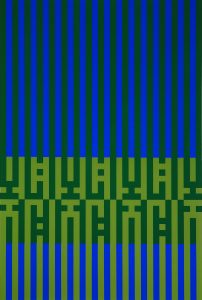
Kamal Boullata – Palestine: a boat and an anchor. Hanan Ashrawi
With a brush and a pen, Boullata was able to combine humanity and nationality, courage and compassion, bravery and humility, nostalgia and devotion. Through all his roles and positions, he maintained the momentum of word and sound, the firmness of his stance, the willpower, the clear vision, and the depth of perception.
The late, great Boullata aimed his compass towards the homeland and confronted the Israeli occupation policies of distortion, theft, and forgery. Through his artistic accomplishments and his critical works, he contributed to the affirmation of Palestinian identity and the development of the global cultural, artistic, and critical scene.
Hanan Ashrawi is a member of the PLO Executive Committee.
A traveler between cultures. Mohammed Al-Asaad
Boullata’s intellectual achievements, marked in his books Palestinian Art- From 1850 to the present (2009) and Recovery of Place: A Study of Contemporary Palestinian Art (2002), presented a much-needed intellectual revival of both Arab and Palestinian cultures. Boullata created an unprecedented account of the history of Palestinian art, highlighting the importance of traveling between times and places, not to write the story of Palestinian art alone but also that of the novel, poetry, critique, and political and intellectual mobility. This scholarly endeavor confirms that the Palestinian diaspora was accompanied by fragmentation on every other level as well, and it is not possible to write about any Palestinian act or activity without alternating between the past and the present, between this place and that. This approach recognizes the Palestinian reality and affirms an indelible, unwavering identity in the face of nearly a century of fragmentation and exile.
Mohammed Al-Asaad is a Palestinian poet, novelist, and literary critic.
Kamal Boullata… the American years. Ibtisam Azem
Boullata moved from painting and diagnostic drawings appended with letters and quotes to a more abstract stage where the letter began to take on a geometric shape. In a number of lectures and interviews, he spoke of the square and the circle as symbols of the earth and the sky. At the beginning of the eighties, Boullata’s interest in shapes and geometry shifted as he started to pay attention to colors and color schemes, dedicating a larger space for these in his works. Perhaps his continued fascination with color was another way to return to the Jerusalemite light that he spoke of on more than one occasion.
Ibtisam Azem is a Palestinian novelist based in New York.
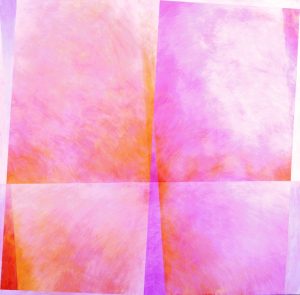
Kamal Boullata: The dreamer of geometric moons. Khaled Najjar
Kamal’s striking works in modernity are based on our mathematical heritage, through Ibn Al-Haytham whom he regards as his first teacher. Kamal tells Westerners: We had an art heritage based on geometry and its cosmic symbols before Victor Vasarely, before the French painter of Russian origin Sergey Polyakov, who also employed mathematical construction, and before Dutch artist Piet Mondrian used the straight line to symbolize masculinity and the straight angle to symbolize femininity in a cosmic unity, combining the principles of masculinity and femininity, the spiritual and the material, incarnation and abstraction… while for Boullata, the circle is a symbol of sky and femininity, close to the Freudian symbols.
Khaled Najjar is a Tunisian poet, translator, and publisher.
Kamal Boullata… Reclaiming the light of Jerusalem. Ameer Dawood
In the works of Kamal Boullata, specifically, And There Was Light (2015), we witness his artistic and intellectual preoccupation with creating an artistic blend between the Arabic letter as the most indicative extension of sound and what can be put to canvas. Boullata accomplished this through what has come to be known as semantic lettering, observing through it the fine art potential embedded in the rules of Arabic calligraphy – a method through which the diacritical marks are combined with color, and traditional Palestinian embroidery with the geometric abstraction of Western modernity, arranging letters as visual elements that express cultural heritage.
His later works were described in what can be referred to as “stability engineering” art, which Boullata founded using translucent paper and “crystallized flicker on canvas” – attempts to shed light on the striking contrast of color and architectural lines, a visual conversation that explores the relationship between light and darkness, a duality that provokes the central concerns of the Palestinian identity, particularly the idea of exile and exclusion, which is deeply embedded in the Palestinian mind.
Ameer Dawood is a Palestinian writer and journalist.
* Tess Waggoner, AAI Remembers Kamal Boullata [online],
Arab American Institute, August 7, 2019, https://www.aaiusa.org/aai_remembers_kamal_boullata
[Accessed 20 Aug. 2019].
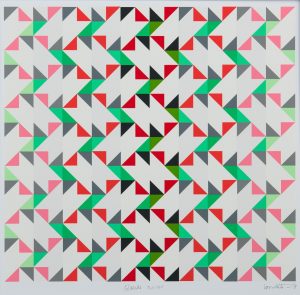
“The composition of this Qasida silkscreen print evolved from studies I had originally undertaken between 1987 and 1990. At the time, I was living in Washington, DC. The media was dominated by the outbreak of the first popular uprising against the Israeli military occupation of the West Bank and the Gaza Strip. The national flag of Palestine, which had been banned by the Israeli authorities, could be seen in every street manifestation. The list of children killed by Israeli sharpshooters for carrying the flag was extensive. Today, other children from the Gaza Strip continue to be targeted for carrying the flag in the Great March of Return. This pattern composition of the Qasida silkscreen print is dedicated to the imperishable spirit of resistance of the people of Palestine. It was created in support of Al-Shabaka, the Palestinian Policy Network.” Kamal Boullata.

